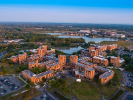Spaulding Quadrangle
Overview
FacilitySPLDNGNumberA146FunctionResidenGross Square Feet143,139Construction Cost$1,639,000CompletedSeptember 1974ArchitectDavis, Brody, & Associates And Miltstein, Wittek, Davis AssociatesFunction
The Ellicott Complex is a 38-building mega-structure consisting of dormitories, dining facilities, academic departments, administrative offices, and classrooms. It was designed to house 3,200 students in the British university system style, with six 'quads' that would focus on subject matter and include faculty as residents, tied to each other by an academic and service core. This system has been abandoned, and various academic departments have relocated to Ellicott as space demands necessitated. Ellicott is notorious for its serpentine corridors and multiple pathways. The Katherine Cornell Theatre, located in the Academic Center core, is named for a well know Buffalo actress. It has long been the location for taping of shows by political satirist, Buffalo-born Mark Russell.
Namesake
![SPLDNG.]()
![Spaulding.]()
Joseph Ellicott (1760-1826), the first resident agent of the Holland Land Company, surveyed the Western New York wilderness in 1798. Ellicott was an early advocate of the Erie Canal. He also mapped out a radial-on-grid plan for the city of Buffalo, similar in design to the earlier plan for Washington, D.C.
Elbridge Gerry Spaulding (1809-1897) was a lawyer, real estate developer, and politician. He served as a mayor of Buffalo and as a New York State assemblyman, congressman, and State Treasurer. Convinced of the possibilities of Buffalo's development, he was to live there for the rest of his life. In his inaugural address, Mayor Spaulding devoted the main part of his remarks to the condition of the Buffalo harbors and shipping facilities. He also alluded at length to the need for a comprehensive sewer system and to the need for proper lighting and paving of the streets, and heartily approved of the free school system. When the University of Buffalo was formed in 1846, he was a member of the original council, and was still a member when he died in 1897. He is buried in Forest Lawn Cemetery.




